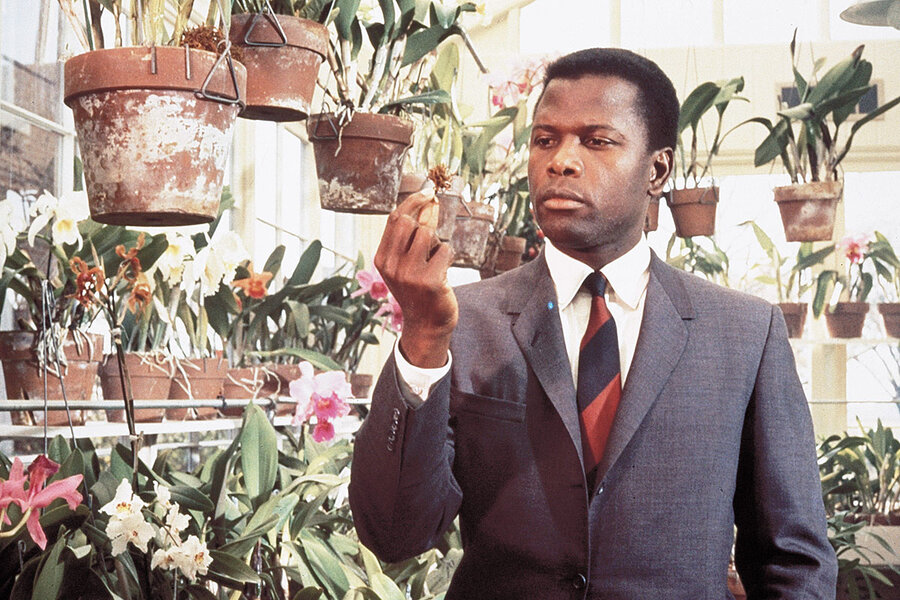Home theater: Spend quality time with the elegant Sidney Poitier
Loading...
Sidney Poitier is, along with Cary Grant, probably the most elegant of all Hollywood movie stars. He is also one of its greatest actors. He brought dignity and grace to virtually all of his roles.
Because I was the writer and co-producer of a 1997 A&E Biography documentary about Poitier, I’d like to try something a bit different and begin this column with a few anecdotes about his life and career.
Editor’s note: As a public service, all our coronavirus coverage is free. No paywall.
Why We Wrote This
When looking for diverting films, one option is to seek out masters of their craft. Film critic Peter Rainer, a longtime champion of Sidney Poitier, notes that the Hollywood great brought dignity and grace to virtually all of his roles.
It may come as a surprise to some that Poitier was born dirt poor in a small island in the Bahamas. He dropped out of school at 13, eventually making his way to New York City, where he was homeless for a time. He was initially rejected by the American Negro Theater because his West Indian accent was so thick no one could understand him.
His first Broadway appearance was a bit part in an all-black production of “Lysistrata.” On opening night he was so nervous he could barely get his lines out. Mortified, he vowed to give up acting and go back to dishwashing. The next day the newspaper reviews appeared and only he escaped censure from the critics. Believing his nervousness was intentional, they hailed the arrival of a new comic talent.
As a struggling young actor in an industry that rarely afforded black performers a chance to shine except as song-and-dance entertainers, Poitier consistently refused to accept demeaning roles. His remarkable debut performance playing a doctor in the racially themed “No Way Out” (1950) should have made him a star, but Hollywood at that time was not ready for that. Seventeen years later, in 1967, he appeared in three of that year’s top 10 grossing movies: “In the Heat of the Night,” “To Sir, With Love,” and “Guess Who’s Coming to Dinner.”
A few years after the A&E documentary aired, never having met him, I was asked to host a gala celebration for Poitier at the Motion Picture Academy’s Samuel Goldwyn Theater in Beverly Hills. Talking with him on stage remains a highlight of my career. In 2011, not having had any interaction with him in the interim, I spotted Poitier at a Governors Awards dinner sponsored by the academy. He was with Oprah Winfrey, who was being honored that night. I wanted to approach him afterward and thank him again for that celebratory evening but was afraid he might not remember me. I didn’t want to tarnish what had been so important a moment for me. But I went ahead anyway and introduced myself. He looked over at me and gave me a big broad smile and said: “I remember it fondly,” stretching that last word into three mellifluous syllables.
Of the many Poitier films I would single out, including “The Defiant Ones” (1958) and the less well-known “Edge of the City” (1957) and “Paris Blues” (1961), the following are three of the strongest.
“In the Heat of the Night”
“In the Heat of the Night,” the 1967 Oscar winner for best picture, is probably Poitier’s most honored, and best, movie. He plays Virgil Tibbs, a Philadelphia police detective who becomes involved in a small town Mississippi murder investigation, facing off against the incessantly gum-chewing local police chief played by Rod Steiger. Years after seeing it, I can’t remember who finally committed the murder. But the real show here is the peerlessly entertaining Poitier-Steiger byplay. There’s also a groundbreaking-for-its-time moment when Tibbs, slapped in the face by a wealthy white racist, slaps back. (Unrated)
“A Raisin in the Sun”
“A Raisin in the Sun,” a 1961 adaptation of Lorraine Hansberry’s award-winning play about a struggling black family in Chicago, has some of Poitier’s strongest work. Acting doesn’t get any better than the scene in which he pleads with his mother (played by the formidable Claudia McNeil) for a better life. (Unrated)
“Lilies of the Field”
Poitier won the best actor Oscar for “Lilies of the Field” (1963), the first black performer to do so. He plays Homer Smith, an itinerant handyman who is roped into building a chapel in rural Arizona for a group of Roman Catholic nuns who have emigrated from Germany. Yes, it’s hokey as all get out. But the hokum is part of its appeal, and Poitier is at his most irresistibly engaging. Amen. (Unrated)
“In the Heat of the Night” and “A Raisin in the Sun” are available for rent on Amazon’s Prime Video, YouTube, Google Play, and iTunes. “Lilies of the Field” is available on iTunes.





